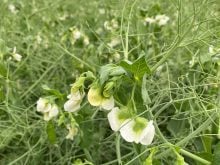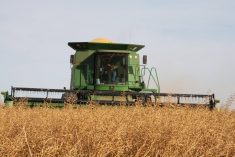Sunflowers in southern Manitoba are starting to come off and early indications point to very good quality.
Ben Friesen, manager of the sunflowers, flax and bird food division, at The Scoular Company based in Winkler, Man., said although only a few samples have come in, what he’s seen so far is promising.
Sunflower growers normally start harvesting in the third or fourth week of October, so Friesen said things are on schedule.
The heavy precipitation that fell recently should not affect too many plants, he said.
Read Also

Crop quality looks good this year across Prairies
Crop quality looks real good this year, with the exception of durum.
“They’re OK, as long as we don’t get a huge snow that will break them down. The snow that just came along now, it just kind of messed things up a bit. It wasn’t breaking them down or anything. So yeah, they’re surviving pretty good.”
Scoular contracts most of the confection sunflowers in Manitoba and have moved into Alberta with some contracts there as well. The company also holds some oilseed contracts.
Prices for oilseed sunflowers are currently in the 22 to 23 cents per pound, while confection sunflowers under contract are in the low-30-cents per lb., he said.
Friesen said prices have been steady for several months as the industry tries to use up a backlog of supply.
“I wouldn’t say we got too much supply, not in the long run, but it is going to take a while. There’s a bit of a bulk that’s been built up here for the last few months. It needs to go through the system.”
He said Scoular is trying to work through the buildup and has been running its plant at full capacity.
In recent years, the sunflower market has gradually shifted away from confection into more oilseed types and that trend continued this year. Based on insured acreage data from Manitoba Agricultural Services Corp., growers seeded 34.6 percent to confection type sunflowers in 2018. The rest were in oilseed types.
Dane Froese, industry development specialist for oilseeds with Manitoba Agriculture, said he believed yields this year will come in higher than Statistics Canada estimates of 1,800 lb. per acre.
StatsCan estimated that sunflower growers would harvest 58,000 tonnes from 70,000 seeded acres this year.
Froese said the key sunflower-growing area south of the Trans-Canada Highway was lucky with weather for the most part and he expected the recent precipitation would not have a great effect.
“So that could work out well in our favour and we could see yields higher than StatsCan reports, but this has yet to be determined as the harvest moves on a little further.”
He added that few disease issues were reported this year and most of the crop standing in fields should do OK. Desiccated sunflowers could be more susceptible to breakage but that hasn’t yet been reported as a major problem.
On the marketing side, Froese said the closure of the Spitz plant in Bow Island, Alta., earlier this year means almost all sunflower seeds grown in Canada are sold into the United States, both confection and oil types.
StatsCan’s estimated 2018 production of 58,400 tonnes, represents at 1.4 percent increase from 2017 production of 57,600 tonnes. The previous five-year average for sunflower production is 57,540 tonnes, but removing the huge crop of 72,600 tonnes in 2015, the four-year average is 53,775 tonnes.
Of 2018 production, Manitoba is expected to have 50,200 tonnes of the total, Saskatchewan 3,500 tonnes, and Alberta growers are expected to harvest 3,600 tonnes.
Outside of the Prairies, Quebec is expected to produce 400 tonnes.

















